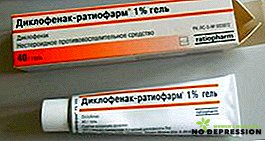Diclofenac is a non-steroidal and anti-inflammatory drug. Opinions of doctors about its use are divided, since this drug (regardless of form) has a lot of contraindications.

Composition and release form
Diclofenac is a drug that has antipyretic, analgesic and anti-inflammatory effect.
Diclofenac is available in the following forms:
- Pills. Covered with a soluble shell. The color is yellow or yellow-orange, the shape is round, slightly discharged. Sold in packs of 10 pcs. and 20 pieces, in one pack - from 1 to 10 packings, in dark glass jars - 30 tablets.
- Solution for intramuscular use. It has a clear color, characteristic smell of benzyl alcohol. Sold in ampoules of 3-5 ml.
- Ointment for external use. Has white color, a weak specific smell. Sold in tubes of 30 ml.
- Gel for external use of 1% or 5%. Color - white or cream.
- Candles. Color - white or yellowish.
The main ingredient is diclofenac sodium. Auxiliary ingredients differ depending on the type of drug:
 Tablets: milk sugar (lactose), sucrose, povidone, potato starch, stearic acid. The composition of the soluble shell includes titanium dioxide, castor oil, liquid paraffin, cellulose.
Tablets: milk sugar (lactose), sucrose, povidone, potato starch, stearic acid. The composition of the soluble shell includes titanium dioxide, castor oil, liquid paraffin, cellulose.- In the solution for intramuscular administration: mannitol, benzyl alcohol, water, sodium hydroxide, propylene glycol.
- In the composition of the ointment: dimexide, propylene glycol, polyethylene oxide.
- As part of the gel: propylene glycol, purified water, lavender oil, Carbopol, triethanolamine.
- In the candlelight: solid fat.
Diclofenac - from what helps, testimony
Diclofenac is used for symptomatic therapy, helps reduce inflammation, reduce pain.
The tool in the form of tablets is used for:
- pain in cancer, toothache or headache;
- radiculitis, neuralgia, arthralgia;
- inflammation in the body following surgery or injury;
- diseases of the musculoskeletal system;
- bursitis, tendovaginitis;
- inflammatory processes in the pelvis;
- pharyngitis, otitis (as part of complex therapy).
The solution for intramuscular injection is used for:
- diseases of the musculoskeletal system (for example, arthritis, osteoarthrosis);
- inflammatory processes in the pelvic organs;
- the appearance of postoperative pain;
- pain syndrome, which is accompanied by inflammation.
Diclofenac ointment or gel is used:
- with traumatic tissue damage;
- in case of muscular pain, including rheumatic origin;
- in diseases of the musculoskeletal system, including arthritis and osteoarthritis of the joints;
- with rheumatic soft tissue lesions.

Very many people are wondering what is better to use - ointment or gel. The main difference is that after applying the gel a small film remains on the skin, which can lead to dry skin, but the ointment, on the contrary, moisturizes the skin and gives it elasticity.
Are there any contraindications?
Diclofenac has a number of contraindications. For example, tablets and candles can not be used for:
- bronchial asthma;
- intolerance to the components of the drug;
- with active gastric bleeding;
- inflammatory bowel disease;
- the presence of a stomach ulcer;
- severe renal failure;
- the presence of progressive kidney disease;
- severe heart failure;
- pregnancy (1 and 2 trimesters) and lactation.
 In addition, this tool is not used for the treatment of children under six years.
In addition, this tool is not used for the treatment of children under six years.
There are additional contraindications. For example, in violation of the absorption of glucose, lactose intolerance should not take pills, suppositories are contraindicated in proctitis.
Also, Diclofenac in these dosage forms should be used with caution in old age, patients with low body mass, with Crohn's disease.
There are contraindications to the use of funds in the form of a solution. These include:
- ulcerative lesions of the gastrointestinal tract;
- problems with blood circulation;
- pregnancy and lactation;
- age up to 16 years;
- sensitivity to the main components of diclofenac.
Do not use ointment and gel:
- if there is damage on the skin;
- in the third trimester of pregnancy;
- children under six years old;
- in the presence of hypersensitivity to the components of the tool;
- during exacerbation of porphyria;
- for disorders of the kidneys and liver;
- with bleeding disorders, including hemophilia.
Diclofenac Dosage and Administration
Diclofenac tablets should be taken inside with a large amount of water. Moreover, for maximum effect, they take a pill 30 minutes before a meal.
Drink pills 2-3 times a day for 25-50 mg, and the daily dose of the drug should not exceed 150 mg.
As soon as the first improvements appear, the dose can be gradually lowered by switching to preventive therapy - 50 mg of the drug per day.
The dosage of Diclofenac in the form of a solution for oral administration is 75 mg of the drug. It is possible to introduce a repeated dose if necessary, but not earlier than after 12 hours. Therapy with a solution can not exceed two days, after which you need to go to the tablets.
 Candles are administered rectally:
Candles are administered rectally:
- adults are prescribed up to 150 mg per day (need to be divided into several doses);
- children over 12 years old - 1 candle twice a day.
When combining several forms of Diclofenac, the daily dose should not exceed 150 mg.
When applying an ointment or cream, the remedy is applied on the skin with a thin layer about 3-4 times a day. The required amount of the drug is determined by the size of the damaged area, but a single dose of Diclofenac cannot exceed 4 g. Children under 6–12 years old do not need to take more than 2 g of the drug.
Can there be side effects?
Before you start using Diclofenac, you need to know about the side effects that may occur when taking the drug.
When taking pills, side effects may occur from the following organs and systems:
- Nervous system. Dizziness, headaches, sleep disturbance, irritability, the appearance of nightmarish dreams, weakness, panic.
- Gastrointestinal tract. Often there is nausea, constipation, abdominal cramps, feeling of bloating, flatulence, bleeding, jaundice, and the appearance of blood in the feces.
- Respiratory system. Bronchospasm, laryngeal edema.
- The cardiovascular system. Chest pain, congestive heart failure.
- Genitourinary system. Fluid retention, papillary necrosis, hematuria, renal failure.
- The skin. Urticaria, rash, itching, dermatitis, eczema, increased photosensitivity.
- Sense organs. Tinnitus, cattle, taste and vision impairment, hearing loss.
- Hematopoietic organs and immune system. For example, anemia, leukopenia, deterioration of the general condition.
In addition, anaphylactic shock can develop, which is very dangerous for health.
When using the agent in the form of a solution, similar side effects are observed.
At the site of the introduction of the composition may appear a burning sensation, tissue necrosis. And when using candles can appear swelling on the skin.
When applied externally, side effects appear very rarely: most often manifested as redness, itching, and the appearance of a small rash.
Special instructions for use
With long-term use of Diclofenac, it is necessary to monitor the work of the liver, you need to pass a stool and blood analysis.
Remember that during therapy with this drug, the reaction rate may decrease, therefore during treatment with Diclofenac, it is advisable for some time to stop driving cars and performing work that require high concentration of attention.


 Tablets: milk sugar (lactose), sucrose, povidone, potato starch, stearic acid. The composition of the soluble shell includes titanium dioxide, castor oil, liquid paraffin, cellulose.
Tablets: milk sugar (lactose), sucrose, povidone, potato starch, stearic acid. The composition of the soluble shell includes titanium dioxide, castor oil, liquid paraffin, cellulose.









